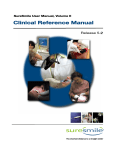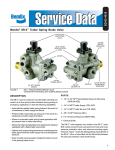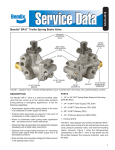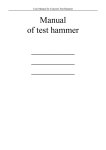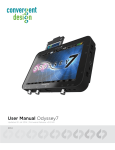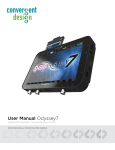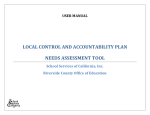Download Installation Operation and Maintenance
Transcript
Franklin Valve L.P. 500 Northpark Central Dr., Suite 100 Houston, Texas 77073 USA (+1) 713-812-7100 www.FranklinValve.com Safety Sign and Label System If and when required, appropriate safety labels have been included in the rectangular margin blocks throughout this manual. Safety labels are vertically oriented rectangles as shown in the representative examples (left and below), consisting of three panels encircled by a narrow boarder. The panels can contain four messages which communicate: • The level of hazard seriousness. • The nature of the hazard. • The consequence of human, or product, interaction with the hazard. • The instructions, if necessary, on how to avoid the hazard. The top panel of the format contains a signal word (DANGER, WARNING, CAUTION or ATTENTION) which communicates the level of hazard seriousness. The center panel contains a pictorial which communicates the nature of the hazard, and the possible consequence of human or product interaction with the hazard. In some instances of human hazards the pictorial may, instead, depict what preventive measures to take, such as wearing protective equipment. The bottom panel may contain an instruction message on how to avoid the hazard. In the case of human hazard, this message may also contain a more precise definition of the hazard, and the consequences of human interaction with the hazard, than can be communicated solely by the pictorial. i Franklin Valve L.P. 500 Northpark Central Dr., Suite 100 Houston, Texas 77073 USA (+1) 713-812-7100 www.FranklinValve.com SectionSubject Page Product Safety and Sign Labeling...................................... i Safety Alerts......................................................................... ii 1.0 Scope of Instruction............................................................ 1 2.0 Cautions............................................................................... 1 3.0 Definitions............................................................................ 1 4.0 Installation........................................................................... 2 5.0 Operation..........................................................................2-3 6.0 Maintenance.....................................................................3-4 7.0 Part Notes............................................................................ 5 Franklin Valve L.P. 500 Northpark Central Dr., Suite 100 Houston, Texas 77073 USA (+1) 713-812-7100 www.FranklinValve.com I. SAFETY ALERTS! READ – UNDERSTAND – PRACTICE 1. WARNING: Allow the system to cool to room temperature before cleaning, servicing or repairing the system. Hot components or fluids can cause severe personal injury or death. 2. WARNING: Always read and comply with safety labels on all containers. Do not remove or deface the container labels. Improper handling or misuse could result in severe personal injury or death. 3. WARNING: Never use pressurized fluids/gas/air to clean clothing or body parts. Never use body parts to check for leaks or flow rates or areas. Pressurized fluids/gas/air injected into or near the body can cause severe personal injury or death. 4. WARNING: It is the responsibility of the owner to specify and provide guarding to protect persons from pressurized or heated parts. Contact with pressurized or heated parts can result in severe personal injury or death. 5. WARNING: Do not allow anyone under the influence of intoxicants or narcotics to work on or around pressurized systems. Workers under the influence of intoxicants or narcotics are a hazard both to themselves and other employees and can cause severe personal injury or death to themselves or others. 6. WARNING: Incorrect service and repair could result in product or property damage or severe personal injury or death. 7. WARNING: These WARNINGS are as complete as possible but not all inclusive. Franklin Valve cannot know all conceivable service methods nor evaluate all potential hazards. 8. WARNING: Use of improper tools or improper use of right tools could result in personal injury or product or property damage. 9. WARNING: This valve product line is not intended for radioactive nuclear applications. Some valve products manufactured by DFC may be used in radioactive environments. Consequently, prior to starting any operation in a radioactive environment, the proper “health physics” procedures should be followed, if applicable. ii Franklin Valve L.P. 500 Northpark Central Dr., Suite 100 Houston, Texas 77073 USA (+1) 713-812-7100 www.FranklinValve.com 1. CAUTION: Heed all service manual warnings. Read installation instructions before installing valve(s). 2. CAUTION: Wear hearing protection when testing or operating valves. 3. CAUTION: Wear appropriate eye and clothing protection. 4. CAUTION: Wear protective breathing apparatus to protect against toxic media. NOTE: Any service questions not covered in this manual should be referred to Franklin Valve’s Service Department, Phone: (+1)713-812-7100 . INSTALLATION, OPERATION AND MAINTENANCE INSTRUCTIONS For DuraSeal Valve 1.0 SCOPE OF INSTRUCTION 1.1. 1.2. 1.3. This information is provided for support of the Duraseal Valve in maintaining the maximum life and function of the valve. The contained information is subject to change without notice. This document provides information for typical installations. In the event of unique situations, please contact your representative or the factory. 2.0 PRECAUTIONS 2.1. 2.2. 2.3. 2.4. 2.5. Ensure that all fluid ports are connected or closed as necessary before applying pressure to equipment. Use proper lifting and supporting equipment to protect personnel and equipment. DO NOT loosen any fasteners, connections or attempt removal until all pressure and mechanical loads are isolated and/or removed from the system. Do remember to use Recognized and Generally Acceptable Good Engineering Practice (RAGAGEP) when inspecting, specifying equipment, and ensuring proper management of change when replacing prior valve with like kind. Do use sound engineering practices consistent with recognize consensus standards, codes, standards, and best practices as part of an ongoing process safety program. 3.0 DEFINITIONS 3.1.DBB - Double Block and Bleed, method to test seat integrity with valve closed while under pressure. 3.2. DIB-1 - Double Isolation and Bleed, Bi-Directional seating. API 6D definition of redundant sealing surfaces in both flow directions. 1 3.3. DTR - Differential Thermal Relief, provides the cavity relief functions of API 6D. Franklin Valve L.P. 500 Northpark Central Dr., Suite 100 Houston, Texas 77073 USA (+1) 713-812-7100 www.FranklinValve.com 4.0 INSTALLATION 4.1. 4.2. 4.3. 4.4. 4.5. 4.6. 4.7. 4.8. 4.9. Ensure that installation location and protection addresses thermal and mechanical hazards, access as necessary for operation and maintenance. Design of piping system and installation location shall provide adequate pressure and temperature protection to prevent exceeding the limits of the valve. Ensure that valve and accessories install freely, properly supported and are free of extraneous loads from connected components. Do not use piping or bolting loads to force valve into position. Ensure that moving parts are clear of interference from adjacent parts and are adequately guarded from contact. Contact temperature is dependent upon the temperature of the contained fluid. Ensure that the valve and piping have proper protection for personnel from high temperature surfaces. Ensure that valve is not the ground path for electrical systems or welding. On gear operated models the handwheel position may be changed as follows: 4.7.1. Place valve in full open position. 4.7.2. Remove gear housing cap screws. Note length of screws and positions. 4.7.3. Turn handwheel to further open the valve – this will turn gear housing. Continue this until handwheel comes to a desired position and the gear housing mounting holed are aligned. 4.7.4. Replace gear housing mounting cap screws. Be sure short cap screws are inserted below worm on worm shaft. Pressure test system before operational start up. Ensure that the valve and attached equipment cycles and operates correctly after installation 5.0 OPERATION 5.1. 5.2. 5.3. 5.4. 5.5. The Franklin DuraSeal Valve is a resilient seated, non-lubricated, plug type valve which utilizes a mechanical action to perform seating and unseating functions. Opening the valve, the plug is raised, retracting the seating slips through their tapered connections. Only after the slips are fully retracted from the body seat, the plug is rotated to the open position. The handwheel and input shaft on the DuraSeal operator are multi-turn. The initial closing rotation of the handwheel results in rotation of the slips and plugs until the slips are positioned over the ports. The position flag shows the direction of the plug port within the valve. Continued closing rotation of the handwheel results in the downward movement of the plug generating an outward movement of the slips for a positive upstream and a downstream shut-off. For proper sealing, the valve must be torqued closed and not positioned only by the flag reference. When DuraSeal Valves are used for DBB service, a manual body bleed valve is required to check seal integrity of the valve in the closed position. DuraSeal Valves are DIB-1 valves and as a result trap internal pressure. This pressure is subject to thermal expansion and can cause a thermal lock. To prevent pressure build up in the body cavity, a DTR is recommended. On valves equipped with DTRs, the body isolation valve (found behind the body flange) must be left open during normal use. The check valve will open at ~25 psi differential pressure, on all valves, and can relieve to any location (normally upstream side of the valve). DTRs are also 2 provided with a manual body bleed valve to check valve seal integrity. Franklin Valve L.P. 500 Northpark Central Dr., Suite 100 Houston, Texas 77073 USA (+1) 713-812-7100 www.FranklinValve.com 5.6. All DuraSeal Valves are manufactured with either an integral handwheel operator or an integral right angle worm gear operator. Both operators are connected to valve stem by a coupling pin. This pin is visible when the valve is in the closed position and lines up with cast holes on the side of the lower gear housing. The valve operator can be removed for inspection by simply driving the coupling pin out and removing the mounting bolts. 5.7. Confirming seal integrity with DBB 5.7.1. Ensure that location and conditions are safe for bleeding line fluid with appropriate fluid capture if applicable. 5.7.2. Close the valve fully. 5.7.3. Drain or bleed body cavity. 5.7.4. If there is an indicated leak, follow 6.8. 5.8. Valve should be operated at least once per month 6.0 MAINTENANCE 6.1. The following activities are recommended to assist the long term performance of the valve. 6.2. Before performing maintenance ensure that the valve is at a safe temperature for handling. Ensure that the contained fluids are safely drained from the valve. 6.3. Regularly check lubrication, observe for leakage, check for mechanical problems by observing any issues of alignment, noise generation, or abnormally warm surfaces. 6.4. Bolting should be occasionally retorqued in high vibration, thermal cycling and high cycle installations. 6.5. Ensure that the valve and operator cycles and operates correctly after maintenance. 6.6. Occasionally, drain plugs in the lower plate and trunnion boss should be removed and the residue flushed and drained. In cold climates but before freezing weather has occurred, any possible collection of water below valve plug or plug trunnion should be drained. 6.7. To displace and prevent moisture from accumulating and freezing, keep the valve operator housing full of lubricant. The operator is provided with a grease fitting. Lubricant should be injected with DuraSeal Valve in the open position only. Use lithium 12 hydroxyl stearate or lithium base mol disulfide grease. Under ordinary conditions, a few pumps of the grease gun semi-annually are sufficient. 6.8. If DBB should indicate a leak which cannot be stopped with ordinary force on handwheel, the following items may provide identification or isolation of leak: 6.8.1.If there is an indicated leak, close the DTR conduit valve. This ensures that fluid is not leaking through a damaged check valve on the DTR. 6.8.2.Operate valve through open-close cycle while fluid is flowing to flush out valve body. After several flushing attempts, close DuraSeal Valve and check body bleed again. If necessary, slips should be inspected and replaced if body bleed still indicates valve leak. 6.8.3.Note that the DBB test confirms that both valve seats are functioning properly. A leak in the DTR or one of the seats may give a DBB leakage indication. The valve has a DIB-1 function. The confirmation of a single seat function requires an additional line isolation. 6.8.4.If leakage continues, check the lower cover plate and trunnion drains for accumulation of solids. With pressure isolated and subject to safety issues on location, drains may be 3 Franklin Valve L.P. 500 Northpark Central Dr., Suite 100 Houston, Texas 77073 USA (+1) 713-812-7100 www.FranklinValve.com flushed to eject any non compacted solids. If there is an indication of compacted solids preventing full movement of the plug, the valve will require disassembly. 6.8.5.If sealing is immediately necessary, the body may be injected with valve sealant. Note that the injected sealant may comingle with line fluids. 6.8.6.The line must be drained to disassemble valve. Then place DuraSeal Valve in open position and check body bleed valve for zero line pressure and remove lower plate. In most cases, the lower plate can be removed by removing the hex nuts that hold the lower plate and rotating the valve to the closed position. This action will push the lower plate off of its seal and allow the lower plate to be removed. After the lower plate has been removed, cycle the valve to the open or the unseated position and this will then allow the slips to be removed from the plug dovetails. Slips can be pulled off dovetails and inspected or replaced if damaged. It is recommended to replace lower plate O-ring and gasket any time lower plate is removed. The valve operator and bonnet can be removed and slips can be replaced from the top of the valve if the lower plate is not accessible for replacing the seating slips. CAUTION: Check body bleed for zero line pressure before removing bonnet. 6.9. If stem packing fails, it can be changed as follows: 6.9.1. Remove operator. 6.9.2. Remove packing gland and replace inner and outer O-rings and backup ring. 6.9.3. Remove and replace packing rings carefully. 6.9.4. Replace packing gland. 6.9.5. Replace operator. 6.10. To change operator heads: 6.10.1. Shut down line pressure. 6.10.2. Close DuraSeal Valve. 6.10.3. Open bleed valve for zero pressure when removing operator. 6.10.4. Drive out coupling pin. 6.10.5. Remove housing mounting bolts and lift operator off. 6.10.6. Replace new operator in reverse order and insert coupling pin from same side as guide pin boss. 6.10.7. Close bleed valve. 6.10.8. Check operation of DuraSeal Valve. 4 Franklin Valve L.P. 500 Northpark Central Dr., Suite 100 Houston, Texas 77073 USA (+1) 713-812-7100 www.FranklinValve.com 7.0 PARTS NOTE: Franklin Valve maintains a supply of slips and seal kits for the DuraSeal Valve as well as other parts. An exchange program is offered on slips, send the old cores in for rebonding and Franklin will exchange them for a new or rebounded pair and a 50% credit will be allowed. When ordering parts for the DuraSeal valve, make sure that the flow media is known. The DuraSeal valve utilizes different rubber compounds to work with the many products that can flow across the valve. WHEN PERFORMING MAINTENANCE ON THE DURASEAL VALVE, ALWAYS MAKE SURE THAT THE VALVE AND IT’S COMPONENTS ARE FREE OF ANY LINE PRESSURE OR ANY MECHANICAL PRESSURE THAT MAY EFFECT THE OPERATION OF THE VALVE. 5








